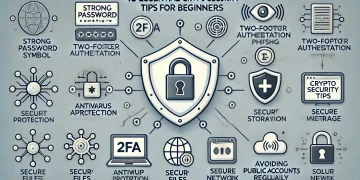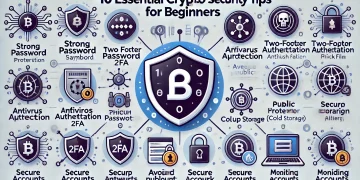Blockchain technology is one of the most talked-about innovations in recent years, but it can be difficult for non-technical people to understand. Even though it’s often associated with cryptocurrencies like Bitcoin, blockchain’s potential goes far beyond digital currencies. This article aims to break down the concepts behind blockchain technology in simple, easy-to-understand terms, making it accessible to anyone, regardless of technical knowledge.
In this guide, we’ll explore what blockchain is, how it works, and why it matters to everyday life. Whether you’re curious about blockchain’s role in industries like finance and healthcare or just want to understand the buzz around it, you’ll find everything you need to know here.
Table of Contents
- What is Blockchain Technology?
- How Blockchain Works: A Step-by-Step Breakdown
- Key Features of Blockchain
- Decentralization
- Transparency
- Security
- Immutability
- What Makes Blockchain Different from Traditional Databases?
- Blockchain and Cryptocurrencies: Are They the Same?
- Types of Blockchain Networks Explained
- Public Blockchain
- Private Blockchain
- Consortium Blockchain
- Real-World Uses of Blockchain Technology
- Finance and Banking
- Supply Chain Management
- Healthcare
- Voting Systems
- Challenges Facing Blockchain Technology
- Scalability
- Energy Consumption
- Regulation
- Future of Blockchain Technology: What’s Next?
- Frequently Asked Questions About Blockchain Technology
1. What is Blockchain Technology?
In simple terms, blockchain is a system for recording information in a way that makes it difficult or impossible to change, hack, or cheat the system. Think of blockchain as a digital ledger (like a notebook) that records transactions. However, unlike a traditional ledger kept by one central authority (like a bank or a government), this ledger is distributed across many computers around the world. This means no single person or company controls the blockchain, which makes it decentralized.
Each time a transaction occurs, it gets recorded in a “block” of data. This block is then added to a chain of previous transactions, forming a “blockchain.” What makes this system so special is that once information is added to the blockchain, it’s extremely hard to change, ensuring transparency and security.
2. How Blockchain Works: A Step-by-Step Breakdown
Let’s break it down into simple steps:
- A Transaction Occurs: Imagine you’re sending money to a friend. In the blockchain world, this transaction gets recorded digitally.
- The Transaction Is Verified: Instead of a bank verifying the transaction, it is checked by a network of computers (called nodes) connected to the blockchain. These nodes ensure the transaction is valid.
- The Transaction Is Grouped Into a Block: Once verified, the transaction is grouped with others to form a block.
- The Block Is Added to the Blockchain: The block is then added to a chain of previous blocks. Each block has a unique identifier (a cryptographic hash) and contains data from the previous block, making the chain secure and tamper-proof.
- The Transaction Is Complete: After the block is added, the transaction is completed, and the information is available to all participants in the blockchain network.
3. Key Features of Blockchain
To understand why blockchain is important, let’s look at its key features.
Decentralization
Most traditional systems, like banks or government databases, are centralized, meaning they are controlled by one entity. Blockchain, on the other hand, is decentralized. This means it’s managed by a network of computers instead of a single entity. This eliminates the need for intermediaries (like banks) and gives users more control over their data and transactions.
Transparency
In a blockchain network, all participants can view transactions. This transparency builds trust among users because everyone can verify the information. For example, if a business uses blockchain to track the supply chain, consumers can see the origin of products and ensure ethical sourcing.
Security
Blockchain uses advanced cryptography to secure data. Each block is linked to the one before it using cryptographic hashes, making it nearly impossible for anyone to alter past transactions without changing all subsequent blocks, which would require an enormous amount of computing power. This makes blockchain extremely secure.
Immutability
Once information is added to the blockchain, it can’t be changed. This immutability makes blockchain especially useful in industries that need to maintain accurate records, such as finance or healthcare.
4. What Makes Blockchain Different from Traditional Databases?
A traditional database, like those used by banks, is centralized, meaning it’s controlled by one party. If that party makes a mistake or is hacked, the entire database could be compromised. Blockchain, by contrast, is decentralized, which means it is spread across multiple computers (nodes).
Other key differences include:
- Centralized vs. Decentralized Control: Traditional databases rely on a central authority, while blockchain relies on a network of users.
- Transparency: Traditional databases don’t allow every participant to view every transaction, while blockchain is transparent to all users.
- Immutability: In traditional databases, data can be modified or deleted. Blockchain records are permanent and unchangeable.
5. Blockchain and Cryptocurrencies: Are They the Same?
Blockchain and cryptocurrencies like Bitcoin are closely related but not the same. Blockchain is the technology that enables cryptocurrencies to exist, but it has many other applications beyond digital currencies.
Here’s a quick analogy: Think of blockchain as the internet and Bitcoin as a website. Just as the internet allows websites to exist, blockchain allows cryptocurrencies like Bitcoin to function. However, just as the internet can be used for more than browsing websites, blockchain can be used for more than just cryptocurrencies.
6. Types of Blockchain Networks Explained
Not all blockchains are created equal. There are different types of blockchain networks, each with unique characteristics:
Public Blockchain
A public blockchain is open to anyone who wants to participate. Anyone can read, write, or verify transactions on the network. This makes public blockchains completely decentralized, but it also means they require a large amount of computational power to validate transactions. Examples include Bitcoin and Ethereum.
Private Blockchain
A private blockchain is restricted to a specific group of participants. Only authorized users can access the network, making it more centralized than public blockchains. Private blockchains are often used by businesses and organizations that want the benefits of blockchain technology but need to control who can participate.
Consortium Blockchain
In a consortium blockchain, multiple organizations share control of the network. This type of blockchain is often used by industries like banking or supply chain management where multiple parties need to collaborate on data sharing.
7. Real-World Uses of Blockchain Technology
While blockchain’s most famous application is in cryptocurrencies, its uses extend far beyond digital money. Here are a few industries that are being transformed by blockchain technology:
Finance and Banking
Banks are exploring blockchain to make transactions faster and more secure. With blockchain, international money transfers can be completed in minutes, instead of days. It also reduces the need for intermediaries, lowering transaction fees.
Supply Chain Management
Blockchain allows businesses to track products through every stage of the supply chain. For example, food producers can use blockchain to track crops from the farm to the supermarket, ensuring product authenticity and safety.
Healthcare
In healthcare, blockchain can be used to securely store patient records, ensuring they remain private but can be accessed by authorized medical professionals when needed. It also provides a way to track the production and distribution of medications, reducing the risk of counterfeit drugs.
Voting Systems
Blockchain has the potential to revolutionize voting systems by making them more secure and transparent. With blockchain, votes can be recorded in a way that prevents tampering while allowing voters to verify that their vote was counted.
8. Challenges Facing Blockchain Technology
Despite its many advantages, blockchain is not without challenges. Here are some of the main issues blockchain faces today:
Scalability
Blockchain networks can be slow, especially public blockchains. As more people use the blockchain, the system can become congested, leading to slower transaction times and higher fees. Developers are working on solutions, like layer-2 scaling and sharding, to make blockchains faster and more efficient.
Energy Consumption
Blockchains that rely on Proof of Work (like Bitcoin) require a lot of computing power to validate transactions. This consumes a significant amount of energy, raising environmental concerns. Newer consensus mechanisms, like Proof of Stake, aim to reduce energy consumption.
Regulation
Because blockchain operates outside traditional financial systems, it has largely existed in a legal gray area. Governments and regulatory bodies are now exploring ways to regulate blockchain-based systems, particularly in areas like cryptocurrencies and data privacy.
9. Future of Blockchain Technology: What’s Next?
The future of blockchain technology looks bright, with continued advancements and growing adoption across industries. Some potential developments include:
- Improved Scalability: Developers are working on solutions to make blockchain networks faster and more scalable, making it easier for businesses to adopt the technology.
- Integration with the Internet of Things (IoT): Blockchain could be used to secure data in IoT devices, ensuring the safety and privacy of connected systems, from smart homes to self-driving cars.
- More Decentralized Applications: As blockchain becomes more widespread, we can expect to see an increase in decentralized applications (dApps) that allow users to interact directly with services without intermediaries.
As the technology matures, blockchain could become a foundation for a more decentralized, secure, and transparent digital world.
Frequently Asked Questions About Blockchain Technology
- What is blockchain technology in simple terms? Blockchain is a system for recording transactions across multiple computers. It’s decentralized, meaning no one person or company controls it.
- Is blockchain only used for cryptocurrencies? No, while blockchain is used to power cryptocurrencies like Bitcoin, it has many other applications, such as in finance, healthcare, and supply chain management.
- Can blockchain be hacked? Blockchain is extremely secure because altering any block requires changing all subsequent blocks, which would require an enormous amount of computing power. However, like any technology, blockchain is not entirely immune to attacks, particularly in poorly designed implementations.
- What are smart contracts? Smart contracts are self-executing contracts with the terms of the agreement directly written into code. They automatically execute and enforce the contract when certain conditions are met.
- What’s the difference between Bitcoin and blockchain? Bitcoin is a digital currency, while blockchain is the technology that underpins Bitcoin. Blockchain can be used for many purposes beyond cryptocurrency.
- Is blockchain really the future? While blockchain is still in its early stages, its potential to revolutionize industries by improving transparency, security, and efficiency suggests that it will play a significant role in the future of technology.
Blockchain technology is transforming the way we think about data, transactions, and security. As its adoption grows, it promises to bring more transparency, efficiency, and trust to a variety of industries, from finance to healthcare. Whether you’re interested in cryptocurrencies or the future of secure, decentralized systems, blockchain is a technology worth watching closely.






























